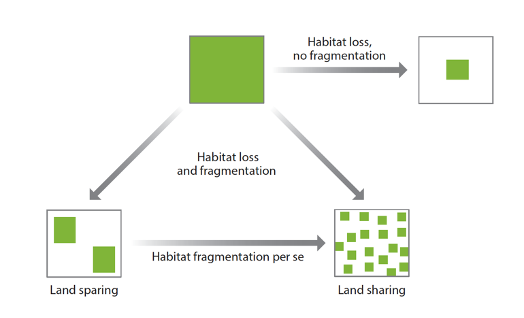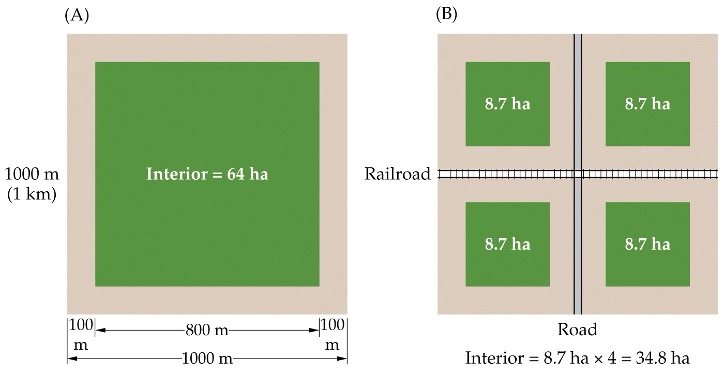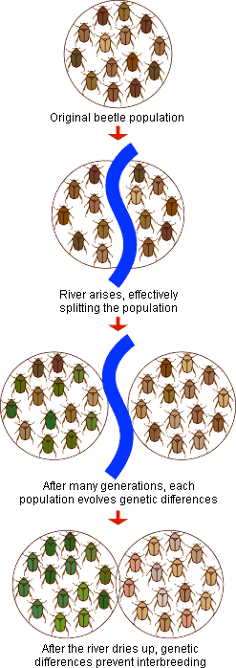Lec 5 - Habitat Fragmentation - E2
1/32
There's no tags or description
Looks like no tags are added yet.
Name | Mastery | Learn | Test | Matching | Spaced |
|---|
No study sessions yet.
33 Terms
Habitat fragmentation
division of large continuous areas of habitat into smaller patches.
What are common causes for habitat fragmentation?
Resource extraction
Urbanization
Roads
Power lines
Agriculture
Fragmentation is the same as habitat loss (T/F).
False. Though the total habitat area is reduced, it is different then habitat loss. Habitat loss is a major threat to biodiversity whereas fragmentation is not necessarily.

What is a major problem fragmentation causes?
Barriers to dispersal. Undisturbed patches might be inaccessible and some organisms would not pass between. Causes bottle neck effect.
What are characteristics of fragmentation?
More edge
Edge to center distance is smaller
Large continuous populations are broken up

Fahrig (2003, 2017)
2003 - general overview and review of key studies.
2017 - review of key studies showing measurable ecological responses to fragmentation.
What did Fahrig found in her studies?
Paradigm shift were 76% were positive. Possible mechanisms is mostly related to how organisms interact with edges. Conclusion is that there is no justification for assigning lower conservation value to a small patch than to an equivalent area with a large patch.
What are some of the consequences to the ecosystem found by Fahrig?
Functional connectivity increase
Habitat diversity increase
Positive edge effect
Predator-prey system stabalize
Competition reduced
spreading extinction risk
Lanscape complementation
1) Increased functional connectivity
Dispersing organisms have a high probability of finding a patch. Abundant edge facilitate movement of edge species.
2) Increased habitat diversity
More structural and environmental heterogeneity provides more niches, higher species diversity.
3) Positive edge effects
Higher productivity because of sunlight, more food and shelter. Lower predation pressure.
4) Stability of predator-prey systems
More refugia, prey can stay ahead of predator.
5) Reduced competition
Edges provide distinct territorial boundaries. Strong competitors often are weak dispersers.
6) spreading extinction risk
Probability of simultaneous extinction in all fragments is low. Metapopulations reproduce and disperse to next patch.
7) Lanscape complementation
Species that requires two distinct habitats have an abundance of both in close proximity.
Name examples of species that thrive under habitat fragmentation.
Seagrass beds.
Grassland insects
Forest owl
Grassland insects
Butterfly diversity higher in smaller fragments, but parasitism of pollen-eating beetles also higher on edges (predator/prey balance).
Forest owls
Owls in forest fragments surrounded by agriculture all depend on forest in different ways.
Great horned - need patch heterogeneity.
Barred - Need large patches.
Northern saw-whet - need patch connectivity.
Extinction filters (Betts et al(2019))
Ecological sensitivity to disturbance increases 6x from poles to tropics, mainly due to “edge effects”.
Temperate/Tropic zones have been shaped by disturbance (fire, hurricane).
Temperate. Tropics are more stable, thus more naive to disturbance.
Proportion of species that require core habitat increases/decreases with increasing latitude.
decreases.
What are the general trends with increasing fragmentation?
Disruption of food webs.
Patches of key resources are inaccessible.
Changes in community composition.
Local species extinctions are not replaced.
Effects are strongest in smaller fragments and tend to magnify over time.
Effects are taxon- and region-specific.
What are some evolutionary consequences of dispersal barriers?
Genetic drift - higher in isolated populations leading to rapid evolutions.
Bottleneck - drastically reduces size of populations, results in:
inbreeding

Biological Corridors
All the habitats needed during the various stages of a species' life cycle (reproduction, growth, shelter).
What are some consequences of biological corridors.
Reduce inbreeding & drift.
Promote gene flow.
How are ecosystems changed by Edge effects.
Altered abiotic and biotic conditions.
Different plant communities
Greater disturbance frequency.
Altered species composition and interspecific interactions.
How do altered abiotic and biotic conditions due to Edge Effect, change the ecosystem?
Greater exposure leads to:
Higher temperature.
Lower humidity
More wind penetration
How do plant communities change due to Edge Effect?
Abiotic changes, more light causes higher tree mortality and increased vine abundance.
How does the Edge effect change disturbance frequencies?
Changes in vegetation and exposure lead to greater disturbance.
Tree falls more common, fires more common.
Dry conditions.
Spillover from agriculture and roads.
How do species interactions change due to Edge effect?
Increased species invasions (e.g., Kudzu).
Roads facilitate dispersal.
Competition and predation higher at edges.
Specialist overtake.
Domesticated animals and diseases spread to wildlife.
Metapopulations
Populations of spatially separated subpopulations linked by migration.
What is the basic model for metapopulations?
Acceptable habitat exist in discrete patches.
All subpopulations have higher extinction rates.
Extinction is prevented by migration.
Metapopulations as conservation tool
Alternate to minimum viable population size.
Maintenance of suitable patches, even if unoccupied, key to preventing extinction.
Unoccupied patches are steppingstones for dispersal.